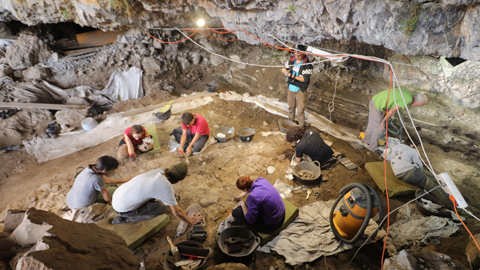Full presence of Neolithic populations in the Pyrenees confirmed
This year's archaeological campaign at the Cueva de Coro Trasito, Huesca, conducted by the High Mountain Archaeological Group of the UAB and the CSIC, confirms the presence of consolidated wheat and barley farming in high areas of the Pyrenees during the first stages of the Neolithic, in addition to diversified livestock farming.

Coro Trasito is considered to be one of the highest altitude excavated caves in the Iberian Peninsula (located at 1548 metres). The 2022 excavation campaign which ended this week made it possible to confirm the signs of a consolidated farming of cereals (wheat and barley) during the Early Neolithic (from 5300 to 4450 BCE). The dig once again served to find abundant remains of cereals. This evidence, alongside the presence of tools used to process the cereals (sickle flakes and mills) and cereal pollen found in several layers of the site, consolidates the innovative image of the presence of farming in high altitudes of the Pyrenees during the early period of the Neolithic Age. This information modifies the traditional image of mountain settlements in the peninsula and particularly in the Pyrenees during the Neolithic Period. According to this notion, human populations in the Pyrenees at the start of the Neolithic Era would have been residual and associated with sheep herding and higher pastures in the summer. The archaeological evidence however reveals a different situation: more stable settlements, with farming, diversification in livestock and a wide range of associated activities.
Located in the municipality of Tella-Sin, within the county of Sobrarbe, the site consists of a large entrance shelter with evidence of having housed livestock at different moments in time: in the modern era, during the Bronze Age (dating back to 1430-1280 BCE) and in the Early Neolithic. The site has been under study since 2011 and all digs have been directed by archaelogists Javier Rey (Government of Aragon's Department of Education, Culture and Sports), Ignacio Clemente (Milà i Fontanals Institution – CSIC) and Ermengol Gassiot (Department of Prehistory, UAB).
Neolithic vestiges
The Neolithic vestiges are what researchers are currently focusing on. They consist of the remains of livestock stabling inside the cave during the Early Neolithic, in a succession covering over one metre. Researchers also documented proof of food storages in small silos built into the ground, as well as moments in which the parts of the cave studied in the dig were found to be work areas. The 45 square metres of dug-up earth allow studying these aspects in detail.
The results are highly valuable in terms of science: first of all, they provide unedited information on the first forms of herding in the High Pyrenees, basically with mixed herds of sheep and goats, cows and pigs. This is contrary to the traditional herding practices from the 19th and 20th centuries, which mainly included mountain cabins for sheep. Another relevant aspect of this research is the wide range of activities conducted by the Neolithic inhabitants: they made pottery, built a variety of tools made out of stone, bones and wood, they processes dairy and in addition to meat from their livestock, they ate a large variety of friuts and used minerals to obtain pigments. Another notable aspect was the attention put on adornments, from necklace beads and shells to marble cracelets, confirming that the settlement came into contact with other geographical areas of the eastern part of the peninsula.
This year's dig once again included the "Excava con el Geoparque de Sobrarbe" programme. Since 2013, the programme invites two volunteers to spend a week working at Coro Trasito as a wau to disseminate the archaeological research conducted at the site. The programme has also offered work placements for UAB archaeology students.
The research at Coro Trasito is conducted under the framework of the research project "Las primeras comunidades agropastorales de la vertiente sur del Pirineo Central (5600-4500 calANE): economía y paisaje" (PID2020-115205GB-I00), funded by the Spanish Ministry for Science and Innovation and co-directed by Ermengol Gassiot and Ignacio Clemente, as well as under the framework of successive editions of the project funded by the Spanish Ministry for Culture and the County of Sobrarbe "Arqueología del pastoralismo en el bien Pirineos- Monte Perdido (vertiente española)".
Related articles:
Gassiot-Ballbè, Ermengol, Mazzucco, Niccolò, Díaz-Bonilla, Sara, Obea-Gómez, Laura, Rey-Lanaspa, Javier, Barba-Pérez, Marcos, Garcia-Casas, David, Rodríguez-Antón, David, Salvador-Baiges, Guillem, Majó-Ortín, Tona and Clemente-Conte, Ignacio. Mountains, Herds and Crops: Notes on New Evidence from the Early Neolithic in the Southern Central Pyrenees. Open Archaeology, vol. 7, no. 1, 2021, pp. 1015-1034. https://doi.org/10.1515/opar-2020-0193
Gassiot-Ballbè, E. et al. (2021). Early Neolithic Farming Activities in High Mountain Landscapes of the Pyrenees: Simulating Changes in Settlement Patterns. In: Pardo-Gordó, S., Bergin, S. (eds) Simulating Transitions to Agriculture in Prehistory. Computational Social Sciences. Springer, Cham. https://doi.org/10.1007/978-3-030-83643-6_8